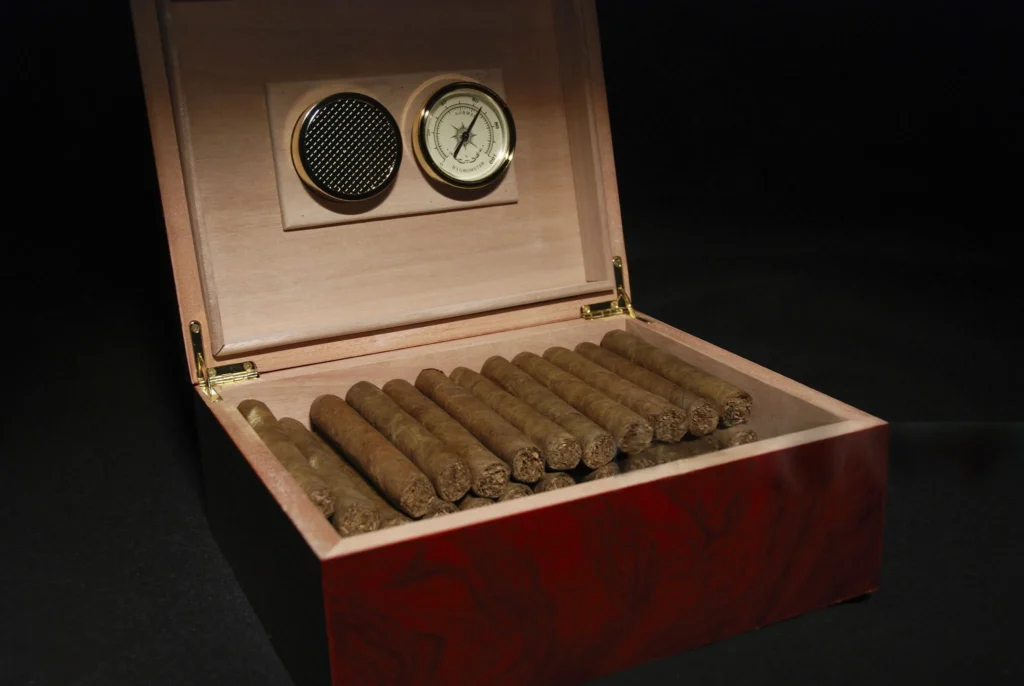Why Cigar Storage Matters
For newcomers and seasoned aficionados, the enjoyment of a fine cigar hinges on more than just its brand or age—it’s about how it’s been stored throughout its lifetime. From the moment a cigar is hand-rolled, it begins a journey sensitive to environmental changes. The minute details in flavor, smoothness, aroma, and draw, each carefully crafted by master blenders, can quickly unravel without proper storage.
While selecting, cutting, and smoking a cigar is personal, ensuring it is preserved at its best is a universal requirement. This is why responsible aficionados look to extensive storage solutions like those found at 1st Class Humidors, which are specifically designed to protect remnants of master craftsmanship until you are ready to light up.
Critically, cigars can lose essential oils and flavor in only a few days if kept in an unstable environment. Studies in tobacco preservation underline how even slight variances in humidity and temperature can lead to rapid quality loss. Mold infestations, beetle outbreaks, and cracked or peeling wrappers can turn a prized collection into a loss.
In-depth industry insight highlights that maintaining the proper storage environment is not just tradition—it is a practical necessity that preserves both the monetary value and the nuanced smoking experience cigars are known for.
Key Factors Affecting Cigar Freshness
Cigar freshness is a fragile art, continually influenced by factors that intersect and magnify one another. Proper humidity—typically between 65% and 72%—prevents cigars from drying out or fostering mold. Too dry, and cigars will crack, lose subtle flavor notes, and cause a harsh or hot smoke. They are too damp and can taste musty, burn irregularly, or even develop visible mold. Daily environmental shifts add an extra challenge in regions with rapid seasonal changes. Temperature plays an equally important role. Prolonged exposure to temperatures above 72°F (22°C) can encourage tobacco beetle activity, ruining entire collections overnight.
In addition, direct light, particularly sunlight or harsh artificial lighting, not only fades wrappers and band colors but also accelerates chemical changes inside the tobacco, degrading aroma and body. As demonstrated by experienced collectors, using humidor cabinets and storing cigars away from windows while maintaining steady conditions is the best insurance against disappointing smokes. These cabinets are specially designed to provide precise humidity and temperature regulation, often combining craftsmanship with digital controls. Investing in one ensures long-term preservation, especially for rare or aging cigars. For serious aficionados, a quality humidor cabinet is not just storage—it’s a commitment to the integrity of every smoke.
There’s so much more to discover—browse our related posts!
Choosing the Right Humidor
The humidor selection should reflect your collection size and passion for the cigar experience. A quality humidor serves as a microclimate, protecting cigars from external threats while subtly enhancing their character as they age. Spanish cedar, still the preferred material among experts, is lauded for its sealing ability and imparting a slight woody aroma that augments aging.
Desktop humidors suit casual smokers or those with space constraints, while serious aficionados gravitate toward larger cabinet humidors or walk-in solutions for their prized stogies. Humidors with adjustable dividers, secondary trays, and transparent lids offer practical organizational benefits. An accurate, easy-to-read hygrometer and a strong, airtight seal are critical for consistent storage. As you build your collection, ensuring your humidor can adapt or expand with your needs minimizes future investments and guarantees cigars always have an ideal resting place.
Setting and Maintaining Humidity Levels
Establishing the ideal humidity level isn’t just a set-and-forget task. It starts with seasoning a new humidor, allowing the wood to absorb moisture slowly so it doesn’t draw water from the cigars. This task involves placing a damp sponge or humidity pack with distilled water inside for up to two days, never using tap water, which can introduce impurities. Beyond this, consistent humidity requires reliable devices
Some prefer low-maintenance gel jars or humidity beads, while technology lovers may invest in electronic systems that are more precise, albeit more costly, whether basic or high-tech; regular inspection and calibration of hygrometers is vital to ensure accuracy.
Digital hygrometers, which often display temperature and humidity, generally provide peace of mind with easy-to-read numbers and built-in calibration. Recording data for trend-spotting and timely intervention is wise. Even the highest-quality humidors can drift without careful monitoring. Beginners and veterans alike can benefit from practical step-by-step guides covering everything from seasoning to daily upkeep in user-friendly language.
Temperature Control Tips
- Always situate your humidor in a place shielded from direct sunlight, such as a closet or den, rather than near windows or under skylights. Direct exposure can cause wide temperature swings and fade wrappers.
- Keep your humidor away from household appliances that emit heat, such as ovens, radiators, or computers. These areas often experience temperature spikes that can destabilize internal conditions.
- Use a room thermometer to monitor the area surrounding your humidor regularly, especially during hot summers or cold winters. Fluctuations may happen more quickly than expected and can go unnoticed if a humidor is placed in a forgotten corner.
- If you live in a region with large temperature swings, consider a temperature-controlled humidor, also known as a humidor cabinet. Some cigar enthusiasts have successfully used wine coolers modified for cigar storage as long as humidity levels are adjusted appropriately.
- Check frequently for condensation inside the humidor. This is an immediate red flag for excessive heat or humidity, which can damage even the finest cigars in a matter of days.
Common Mistakes and How to Avoid Them
New collectors are sometimes caught off guard by the speed with which cigars can spoil when mistakes are made. Overfilling is a widespread error, as stacking cigars too tightly inhibits air circulation and prevents even humidity distribution. This often leads to inconsistent burn and can compromise an entire batch.
Skipping the seasoning phase with a new humidor results in the wood absorbing moisture directly from the cigars, causing dryness and spongy textures. Likewise, using tap water in humidification devices, while convenient, can leave mineral deposits inside both the humidor and the cigars, tainting flavor profiles over time.
- Never exceed the humidor’s recommended capacity—it’s better to have space than risk poor aging.
- Season a new humidor thoroughly with distilled water before adding premium sticks.
- Avoid removing cigars from their cellophane until you’re ready to age or smoke them, as the wrapper provides a small extra layer of protection.
- Log all maintenance checks, including humidity settings, seasoning dates, and any changes, to ensure accountability and easy troubleshooting.
- Set a monthly schedule for checking humidifier and hygrometer performance, with additional checks during extreme seasonal weather.
Long-Term Cigar Storage Strategies
Long-term storage demands careful planning for collectors building substantial inventories or hoping to age cigars for deeper flavors. Many aficionados rotate their cigars regularly—even flipping the rows and moving boxes within the humidor—to ensure full exposure to humidity and prevent sections from becoming stale.
Keeping similar blends or brands together makes it easier to monitor progress and ensures tobacco characteristics are not muddied over time. Vacuum-sealed bags with integrated humidity packs offer a temporary solution when overflow occurs. However, a well-maintained humidor remains the gold standard for extended aging, especially with rare or vintage sticks.
Document every box code, date of purchase, and tasting note to track how cigars change with age and inform future purchases. High-value cigars, in particular, deserve periodic inspections for beetle holes, mold, or wrapper separation. Investing in storage cabinets with lockable doors or even integrated alarms can add extra peace of mind for those preserving cigars as family heirlooms or potential investments.
Trends in Cigar Collecting and Preservation
Cigar collecting is seeing a renewed surge, driven by an appetite for rare releases and a fascination with aging. Smart humidors—offering Bluetooth or WiFi connectivity—allow enthusiasts to monitor humidity and temperature remotely and receive real-time alerts, making it easier to respond before problems arise. Adjustable shelving, modular interiors, and built-in LED displays are becoming common, reflecting changing needs among both growing and established collections.
Recent industry guides and reviews focus on personalization and ease of use. Today’s most sought-after humidors regulate the environment scientifically and blend seamlessly with home and office interiors, serving as conversation pieces and preservation tools. As the community grows more passionate and discerning, keeping up with innovations in storage is key to ensuring every cigar—no matter how old or valuable—delivers the rich, complex flavors that define a superior smoking experience.
Keep exploring—our other articles are packed with helpful info!







